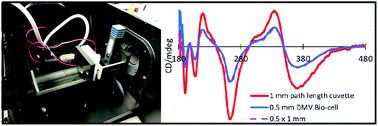Minimising sample volume and run times for circular dichroism spectroscopy
Abstract
Circular dichroism (CD) spectroscopy is widely used to characterise chiral structures in solution, including to determine protein secondary structure content. However, protein CD experiments typically require 10–20 μg of protein. An additional challenge is that some proteins change their structure when their concentration is changed (they unfold or aggregate) so, particularly for protein biopharmaceuticals, it is attractive to have a range of different path lengths to hand. This paper reports the validation of demountable DMV Bio-cells of path lengths 0.5 mm, 0.2 mm and 0.125 mm, which have approximately 1 mm diameter windows, for CD spectroscopy. When complemented with a 10 cm focal length focusing lens positioned 9.5 cm in front of the sample, the signal : noise ratio of the final spectrum is equivalent to data collected on a standard cell wide enough to allow the full light beam to pass through. The DMV Bio-cells require 2–3% of the sample needed for a standard full-width cuvette and can be assembled without bubbles with the nominal path length. In addition, they are easy to clean and less likely to be chipped or broken than standard cuvettes which, together with the sample saved, compensates for their much higher price. For smaller path lengths the Jasco MSD-462 microsampling disk enabled fairly reproducible assembly at 4–7 μm depending on the sample viscosity and similarly high quality data.



 Please wait while we load your content...
Please wait while we load your content...